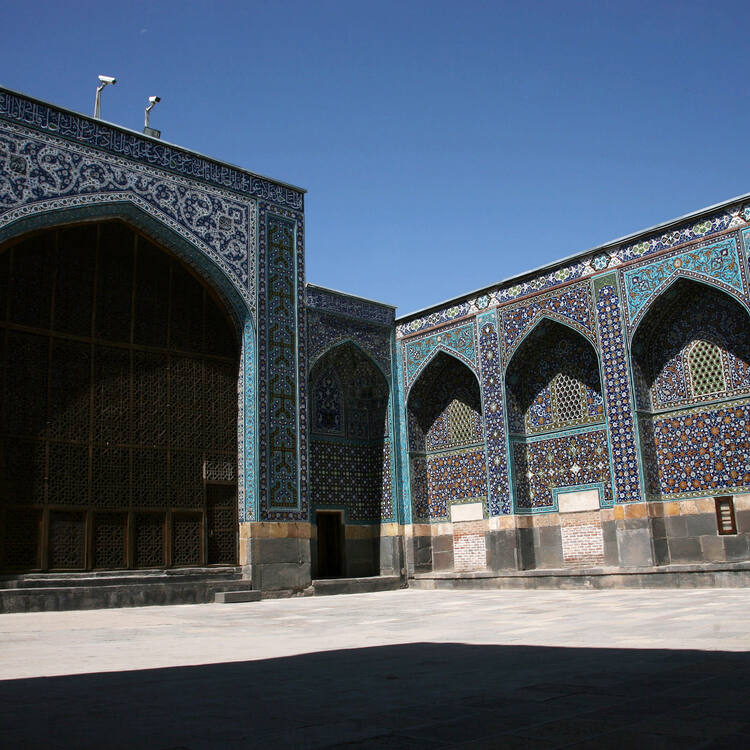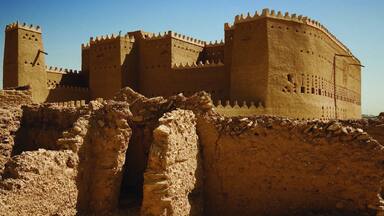Sheikh Safi al-din Khānegāh and Shrine Ensemble in Ardabil
Sheikh Safi al-din Khānegāh and Shrine Ensemble in Ardabil
Built between the beginning of the 16th century and the end of the 18th century, this place of spiritual retreat in the Sufi tradition uses Iranian traditional architectural forms to maximize use of available space to accommodate a variety of functions (including a library, a mosque, a school, mausolea, a cistern, a hospital, kitchens, a bakery, and some offices). It incorporates a route to reach the shrine of the Sheikh divided into seven segments, which mirror the seven stages of Sufi mysticism, separated by eight gates, which represent the eight attitudes of Sufism. The ensemble includes well-preserved and richly ornamented facades and interiors, with a remarkable collection of antique artefacts. It constitutes a rare ensemble of elements of medieval Islamic architecture.
Description is available under license CC-BY-SA IGO 3.0
Ensemble du Khānegāh et du sanctuaire de Cheikh Safi al-Din à Ardabil
Construit entre le début du 16e siècle et la fin du 18e siècle, ce lieu de retraite spirituelle soufi utilise les formes architecturales traditionnelles iraniennes. Les constructeurs ont su tirer le meilleur parti de l'espace réduit pour assurer de multiples fonctions, notamment une bibliothèque, une mosquée, une école, un mausolée, une citerne, un hôpital, des cuisines, une boulangerie et quelques bureaux. Le site comprend un cheminement conduisant au sanctuaire du Cheik articulé en sept étapes qui reflètent les sept stades du mysticisme soufi, séparées par huit portes qui représentent les huit attitudes du soufisme. Le site comprend également des façades et des intérieurs richement ornementés ainsi qu'une remarquable collection d'objets anciens. Il forme un rare ensemble d'éléments d'architecture islamique médiévale.
Description is available under license CC-BY-SA IGO 3.0
مجموعة الخانقه وحرم الشيخ صفيّ الدين في أردبيل
يتسم هذا المكان المخصص للخلوات الروحية الصوفية، الذي أُنشئ في الفترة ما بين بداية القرن السادس عشر ونهاية القرن الثامن عشر، بأشكال معمارية تقليدية إيرانية. وقد استغل الذين شيدوا هذا المكان المساحة الضيقة لإقامة أسواق، وحمامات عامة، وميادين، وأماكن للعبادة، ومساكن ومكاتب. كما أنهم رسموا طريقاً يفضى إلى ضريح الشيخ صفي الدين ينقسم إلى سبعة مواقف تعكس الأطوار السبعة في المذهب الصوفي. وفضلاً عن ذلك، يتسم هذا الموقع بزخارف خارجية وداخلية كثيرة، ويضم مجموعة متميزة من التحف القديمة. ويشكل الموقع مجموعة نادرة لعناصر معمارية إسلامية يرقى تاريخها إلى العصر الوسيط.
source: UNESCO/CPE
Description is available under license CC-BY-SA IGO 3.0
阿尔达比勒市的谢赫萨菲•丁(Sheikh Safi al-Din)圣殿与哈内加(Khānegāh) 建筑群
谢赫萨菲•丁(Sheikh Safi al-Din)圣殿与哈内加建筑群是伊斯兰教苏菲派的精神休憩之所。这一建筑群建于16世纪初至18世纪后期,采用伊朗传统的建筑形式,将有限的空间最为有效地加以利用,因而诸多功能于一身(包括一个图书馆,一所清真寺、一所学校、几个大型陵墓、一个地下蓄水池、一所医院、若干厨房、一个糕饼店和一些办公室)。前往神庙的道路被八道门分为七段,分别代表着苏菲神秘主义的八个理念和七个发展阶段。在这一保存完好的遗址中,人们可以看到丰繁精美的建筑外观与内部装饰,以及一批出色的古董收藏。这一建筑群作为中世纪伊斯兰建筑元素的大集合,是当今非常罕见的。
source: UNESCO/CPE
Description is available under license CC-BY-SA IGO 3.0
Ханега и святилища шейха Сафи аль-Дин в Ардабиле
Создававшееся с начала шестнадцатого и до конца восемнадцатого века, это сооружение - место духовного уединения суфистов - отличается традиционными иранскими формами архитектуры. Его строители смогли наиболее рационально использовать большую часть ограниченного пространства, разместив там, например, библиотеку, мечеть, школу, мавзолей, водный резервуар, госпиталь, кухни, булочную и рабочие помещения. Путь, ведущий к святилищу шейха, разделен на 7 сегментов, отражающих семь этапов суфийского мистицизма, и разделен 8 воротами, символизирующими восемь положений суфизма. Памятник также включает богато украшенные фасады и интерьеры и замечательную коллекцию антиквариата. Он является редчайшим образцом средневековой исламской архитектуры.
source: UNESCO/CPE
Description is available under license CC-BY-SA IGO 3.0
Conjunto del Khānegāh y del santuario del Jeque Safi Al Din en Ardabil
Este conjunto monumental es un sitio de retiro espiritual sufi que fue construido en los estilos arquitectónicos tradicionales iraníes, entre principios del siglo XVI y finales del siglo XVIII. Sus constructores aprovecharon al máximo el espacio relativamente reducido de que disponían para crear bazares, baños públicos, plazas, lugares de culto, viviendas y oficinas. También crearon un itinerario de acceso al mausoleo del Jeque Safi Al Din estructurado en siete etapas que corresponden a los siete estados místicos del sufismo. Formado por un conjunto excepcional de elementos de la arquitectura islámica medieval, el sitio cuenta con fachadas e interiores ricamente ornamentados y con una notable colección de objetos antiguos.
source: UNESCO/CPE
Description is available under license CC-BY-SA IGO 3.0
アルダビールのシェイフ・サフィー・ユッディーンの修道院と聖者廟複合体
イスラーム神秘主義スフィーの隠遁所として、16世紀初めから18世紀末に、イランの伝統的なイスラーム建築様式を用いて建設された。造営者たちは、限られた空間を最大限に利用し、素晴しい図書館やモスク、学校、霊廟、貯水槽、病院、調理場、パン工房、いくつかの事務所などを造りあげた。長老(シェイフ)の墓所へと至る敷地構成は、イスラーム神秘主義の7つの階段を示す7つの場面に分節され、8つの心構えを示す8つのドアで分けられる。また、著名な骨董美術の集成だけでなく、外観にも内部にも豊かな装飾が施されている。中世イスラーム建築の要素を結集させた希少な遺産である。source: NFUAJ
Khānegāh en heiligdomcomplex van Sjeik Safi al-Din in Ardabil
Het complex van Sjeik Safi al-Din is een spirituele plek in de soefi-traditie, gebouwd tussen het begin van de 16e eeuw en het einde van de 18e eeuw. Er is gebruik gemaakt van Iraanse traditionele architectonische vormen om de beschikbare ruimte te maximaliseren en zo de verscheidenheid van functies te faciliteren. Het complex omvat een bibliotheek, moskee, school, mausolea, ziekenhuis, bakkerij en een aantal keukens en kantoren. Er is ook een route naar het heiligdom van de Sjeik, verdeeld in zeven segmenten, die de zeven stadia van de soefi-mystiek weerspiegelen en gescheiden door acht poorten, die de acht houdingen van het soefisme vertegenwoordigen.
Source: unesco.nl
Outstanding Universal Value
Brief synthesis
Sheikh Safi al-Din Khānegāh and Shrine Ensemble was built as a small microcosmic city with bazaars, public baths, squares, religious buildings, houses, and offices. It was the largest and most complete khānegāh and the most prominent Sufi shrine since it also hosts the tomb of the founder of the Safavid Dynasty. For these reasons, it has evolved into a display of sacred works of art and architecture from the 14th to the 18th century and a centre of Sufi religious pilgrimage.
The Sheikh Safi al-Din Khānegāh and Shrine Ensemble in Ardabil is of Outstanding Universal Value as an artistic and architectural masterpiece and an outstanding representation of the fundamental principles of Sufism. Ilkhanid and Timurid architectural languages, influenced by Sufi philosophy, have created new spatial forms and decorative patterns. The layout of the ensemble became a prototype for innovative architectural expressions and a reference for other khānegāhs. As the shrine of a prominent Sufi master, who also was the founder of the Safavid Dynasty, the property has remained sacred in Iran up to the present day.
Criterion (i): The conception of the entire ensemble layout, the proportions of the internal and external spaces and of the buildings, their design and refined decoration, together with the climax created by the sequenced path to Sheikh Safi al-Din’s shrine, all combined, have concurred to create a unique complex in which aesthetics and spirituality are in a harmonious dialogue.
Criterion (ii): The architectural spaces and features of the nominated property have integrated influences of the Ilkhānid and Timurid periods with the religious message of Sufism and the taste for exquisite ornamentation and interior spaciousness, thus giving rise to fresh architectural and artistic forms.
Criterion (iv): The Sheikh Safi al-Din ensemble is a prototype and an outstanding example of a 16th century religious complex, combined with social, charitable, cultural, and educational functions, which contains all the significant elements that since came to characterize Safavid architecture and became a prototype for other khānegāh and shrines.
Integrity and Authenticity
The property contains all the elements that convey its Outstanding Universal Value. Most of the elements of the property are in good condition and, despite several transformations, the site continues to present an image of harmonious composition, in which the material realization of the spiritual path through the architectural design is still clearly legible. The State Party has taken steps to restore the original access to the ensemble, which will strengthen the connection between the architecture and the Sufi spiritual messages.
The design form of the entire complex and of individual buildings has been retained and their religious functions have been maintained in most cases. Where they have changed, the new uses are appropriate to the architectural structure in general, and the material and technical authenticity has been retained, as well as the spiritual character of the place. It is, however, important to reduce the tendency to go too far in conservation work.
Protection and management requirements
The nominated property has been protected under the Iranian legislation since 1932. According to the law currently in force, special protection provisions are in place for the property, the buffer zone and for a wider area called the ‘landscape zone.’ These provisions, already in place, are also being incorporated into the revised Master Plan for Ardabil, final approval of which is scheduled for September 2010.
Any project concerning protected monuments in Iran must be in accordance with the provisions of the law and must be approved by ICHHTO, the authority in charge of the protection of Iranian monuments. The management framework established for the nominated property integrates the regulations for Sheikh Safi al-Din Khānegāh and Shrine Ensemble and the provisions of the Ardabil Master Plan.
Management of protected monuments is the responsibility of the High Technical Council of ICHHTO, which approves budgets and all major conservation works. Minor works and day-to-day maintenance is ensured by a steering committee which can avail itself of a multidisciplinary team (the ICHHTO Sheikh Safi al-Din Ensemble Base), which is headed by a urban planner and includes on its staff engineers, architects, conservation architects, and archaeologists.



